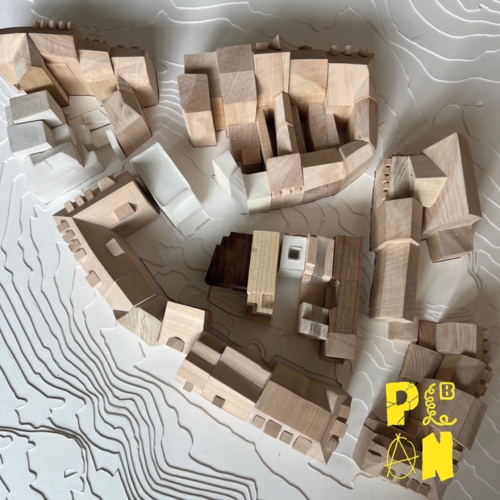
What moves us at summaery2024? Part 3: Faculty of Architecture and Urbanism
What could the future of vacant spaces look like? How can regional material cycles and sustainable construction methods be used? How can the future issues of town and country be solved? These are just some of the questions that students at the Faculty of Architecture and Urbanism will answer in their semester projects and exhibit at the summaery in and around the main building of the Bauhaus-Universität Weimar.
Ideas for Weimar
Everyone knows them: dingy abandoned spaces or overgrown parking lots. Spaces that, if repurposed and upgraded, could be attractive urban areas – as demonstrated by students working on two local projects. The area between Mostgasse, Hinter der Badestube and Bornberg in Weimar's city centre is one of the oldest residential areas in Weimar. Today it is a wasteland. Architecture students have been experimenting with what the area could look like and have developed ideas for communal living and commercial uses with their »most[ver]dichter« project. An additional testing ground for student designs in Weimar is the former industrial area between Asbach und Gaswerk. The »Westend Weimar« project involves students who have taken advantage of the area’s potential to become a mixed green space neighbourhood that aligns with the model of the »produktiven Stadt« (productive city). A unique element of the project is that Architecture students and Urbanism students are working together.
Student Collaboration Projects
Prof. Dr. Sigrun Langner, Dean of the Faculty of Architecture and Urbanism and Professor of Landscape Architecture and Planning elaborates: »In shared design studios, students learn how to work in teams to develop urban designs in phases that build upon one another. They begin by analysing and conceptualising, and then move on to developing plans and models. By doing so, they contribute their own expertise and learn how to understand and interpret the other discipline. This allows them to expand their own skill set to include those from the other subject. This aligns with the interdisciplinary culture of study and exchange that characterises the project-based course of study in our faculty and the interdisciplinary cooperation between the faculties at the university.«
Regional Topics
Can the original idea of the city ring road as a boulevard for citizens be restored? Using the example of Erfurt’s Juri-Gagarin-Ring, students working on the »Common Ground« project are showing what unifying urban architecture can look like. This offers, on the one hand, a mindful relationship with the existing architecture and, on the other hand, makes the heterogeneous architecture of the last century more usable and understandable. After all, public space is an essential element of the European city and, as such, should be designed in a way that makes it once again a common ground and basis of understanding for everyone.
Regional Building Materials
Architecture and Civil Engineering students in the »Ziegelpraxis« seminar take a practical approach to regional building materials. Brickwork is very common in the rural Vogtland region, evidence which can be seen in the area’s brick-built industrial heritage. The project focussed on how the brick production is carried out, the properties of loam and clay, and how the materials can be used in architecture. The participants analysed, evaluated and prepared clay taken from the site in the laboratory. They then shaped the clay and »baked« bricks themselves.
International Perspectives
Many of the projects in the annual exhibition look beyond Thuringia and Germany and focus on locations in Prague, Milan, the pioneering district of Rothneusiedl in Vienna, the railway station area in Lviv, Ukraine, and Rio de Janeiro.
summaery2024 Highlights:
The projects not only reflect the wide thematic and geographical range that the budding architects and urbanists will encounter in their professions - they also invite visitors to engage with solutions to pressing future issues such as the ecologically and socially sustainable development of architecture, cities and landscapes. All information on summaery2024 can be found at: www.uni-weimar.de/summaery
